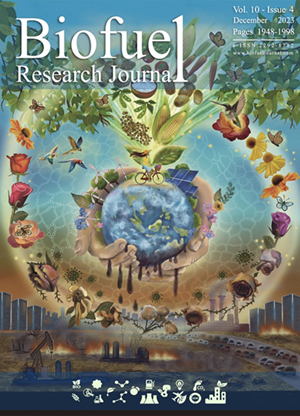Candida rugosa lipase nanoparticles as robust catalyst for biodiesel production in organic solvents
IF 11.9
Q1 ENERGY & FUELS
引用次数: 19
Abstract
Inexpensive but resourceful sources of lipids, for example, used cooking oil (UCO) and brown grease (BG), which often contain large amounts of free fatty acids (FFA), are difficult to convert into biodiesel economically and in good yield. Candida rugosa lipase nanoparticles (cNP) were formed first and subsequently cross-linked nanoparticles (CLNP) were obtained by crosslinking of them. Alternatively, cNP were conjugated to magnetic nanoparticles (mNP) to achieve a cNP-mNP conjugate. All three formulations were employed in three different organic solvents (n-heptane, 1,4-dioxane, and t-butanol) to produce biodiesel using BG and UCO in the transesterification reaction with ethanol and methanol. The radii of nanoparticles (NP) were 5.5, 75, 100, 85 nm for mNP, cNP, CLNP, and cNP-mNP, respectively, as measured by scanning/transmission electron microscopy and dynamic light scattering. The catalytic efficiency (Kcat/KM) of cNP, CLNP, and cNP-mNP was increased ca. -25, -68, -176 folds in n-heptane and -35, -131, -262 folds in 1,4-dioxane compared to the lyophilized lipase in the model transesterification reaction of p-nitrophenyl palmitate (PNPP) with ethanol. In biodiesel formation, the best performance with 100% conversion of BG was achieved under optimum conditions with cNP-mNP, ethanol at a 1:3 molar ratio of lipid-to-alcohol, NP at a 1:0.1 weight ratio of lipid-to-enzyme, and water at a 1:0.04 weight ratio of enzyme-to-water at 30 oC for 35 h. The operational stability of the CLNP and cNP-mNP was sustained even after five consequent biodiesel batch conversions while 50% and 82% residual activity (storage stability) were retained after 40 d.rugosa假丝酵母脂肪酶纳米粒子作为有机溶剂中生物柴油生产的强大催化剂
廉价但资源丰富的脂质来源,例如,通常含有大量游离脂肪酸(FFA)的食用油(UCO)和棕色油脂(BG),很难经济且高产地转化为生物柴油。首先形成皱纹念珠菌脂肪酶纳米颗粒(cNP),然后通过交联获得交联纳米颗粒(CLNP)。或者,将cNP缀合到磁性纳米颗粒(mNP)上以获得cNP-mNP缀合物。所有三种制剂都在三种不同的有机溶剂(正庚烷、1,4-二恶烷和叔丁醇)中使用BG和UCO与乙醇和甲醇进行酯交换反应来生产生物柴油。通过扫描/透射电子显微镜和动态光散射测量,对于mNP、cNP、CLNP和cNP-mNP,纳米颗粒(NP)的半径分别为5.5、75、100、85nm。在对硝基苯基棕榈酸酯(PNPP)与乙醇的酯交换反应模型中,与冻干脂肪酶相比,cNP、CLNP和cNP-mNP的催化效率(Kcat/KM)在正庚烷中提高了约-25、-68、-176倍,在1,4-二恶烷中增加了约-35、-131、-262倍。在生物柴油的形成中,在最佳条件下,cNP-mNP、脂醇摩尔比为1:3的乙醇、脂酶重量比为1:0.1的NP和酶水重量比为1:1.04的水在30℃下保持35小时,获得了BG 100%转化的最佳性能。即使在随后的五次生物柴油分批转化之后,CLNP和cNP-mNP的操作稳定性仍然保持,而在40d之后保留了50%和82%的残留活性(储存稳定性)。
本文章由计算机程序翻译,如有差异,请以英文原文为准。
求助全文
约1分钟内获得全文
求助全文
来源期刊

Biofuel Research Journal-BRJ
ENERGY & FUELS-
CiteScore
22.10
自引率
1.50%
发文量
15
审稿时长
8 weeks
期刊介绍:
Biofuel Research Journal (BRJ) is a leading, peer-reviewed academic journal that focuses on high-quality research in the field of biofuels, bioproducts, and biomass-derived materials and technologies. The journal's primary goal is to contribute to the advancement of knowledge and understanding in the areas of sustainable energy solutions, environmental protection, and the circular economy. BRJ accepts various types of articles, including original research papers, review papers, case studies, short communications, and hypotheses. The specific areas covered by the journal include Biofuels and Bioproducts, Biomass Valorization, Biomass-Derived Materials for Energy and Storage Systems, Techno-Economic and Environmental Assessments, Climate Change and Sustainability, and Biofuels and Bioproducts in Circular Economy, among others. BRJ actively encourages interdisciplinary collaborations among researchers, engineers, scientists, policymakers, and industry experts to facilitate the adoption of sustainable energy solutions and promote a greener future. The journal maintains rigorous standards of peer review and editorial integrity to ensure that only impactful and high-quality research is published. Currently, BRJ is indexed by several prominent databases such as Web of Science, CAS Databases, Directory of Open Access Journals, Scimago Journal Rank, Scopus, Google Scholar, Elektronische Zeitschriftenbibliothek EZB, et al.
 求助内容:
求助内容: 应助结果提醒方式:
应助结果提醒方式:


